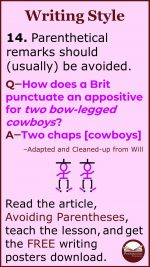Don’t Use Metaphors in Essays
“My life is a tree. It has deep roots, but it needs to be watered so that it can branch out and touch the sky,” Pablo wrote in his essay introduction.
“Wow! That tree needs to be pruned a bit; I would leaf the extended metaphors to your poetry,” I suggested.
“Oh, I get it. Only formal, literal writing for essays,” sighs Pablo.
Definitions and Examples
A metaphor is an implied (suggested) comparison of two unlike things. Example: Love is a rose
An extended metaphor continues the comparison through several sentences in a story or through several lines in a poem. Example: “Love is a rose, but you better not pick it. It only grows when it’s on the vine. A handful of thorns and you’ll know you’ve missed it. You lose your love when you say the word mine.” (Neil Young)
Read the rule.
Don’t use metaphors or other figures of speech in essays.
Practice
Write the sentences and [bracket] the metaphors.
- My heart is broken. I feel so blue, but I know that time will heal all wounds.
- That student is always fishing for compliments. She has absolutely no self-confidence.
- Life is a journey, but the first step is often the scariest.
- Working with her study group was worse than swimming in a sea of sharks.
- She is walking a tightrope with her boss on making a profit and cutting costs.
Revise the sentence by eliminating the metaphors.
Even if a metaphor hits a home run, it can be over-played.
Answers
- My [heart is broken]. I [feel so blue], but I know that [time will heal all wounds].
- That student is always [fishing for compliments]. She has absolutely no self-confidence.
- [Life is a journey], but the [first step] is often the scariest.
- Working with her study group was worse than [swimming in a sea of sharks].
- She is [walking a tightrope] with her boss on making a profit and cutting costs.
For more essay rules and practice, check out the author’s TEACHING ESSAYS BUNDLE. This curriculum includes 42 essay strategy worksheets corresponding to teach the Common Core State Writing Standards, 8 on-demand writing fluencies, 8 writing process essays (4 argumentative and 4 informative/explanatory), 64 sentence revision and 64 rhetorical stance “openers,” writing posters, and helpful editing resources.
Differentiate your essay instruction in this comprehensive writing curriculum with remedial writing worksheets, including sentence structure, grammar, thesis statements, errors in reasoning, and transitions.
Plus, get an e-comment bank of 438 prescriptive writing responses with an link to insert into Microsoft Word® for easy e-grading (works great with Google Docs),
Download the following 24 FREE Writing Style Posters to help your students learn the essay rules. Each has a funny or ironic statement (akin to “Let’s eat Grandma) to teach the memorable rule.










